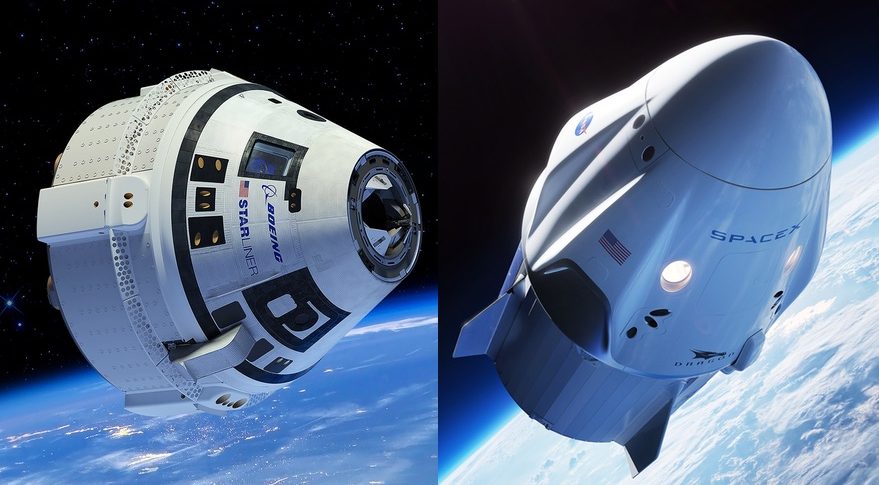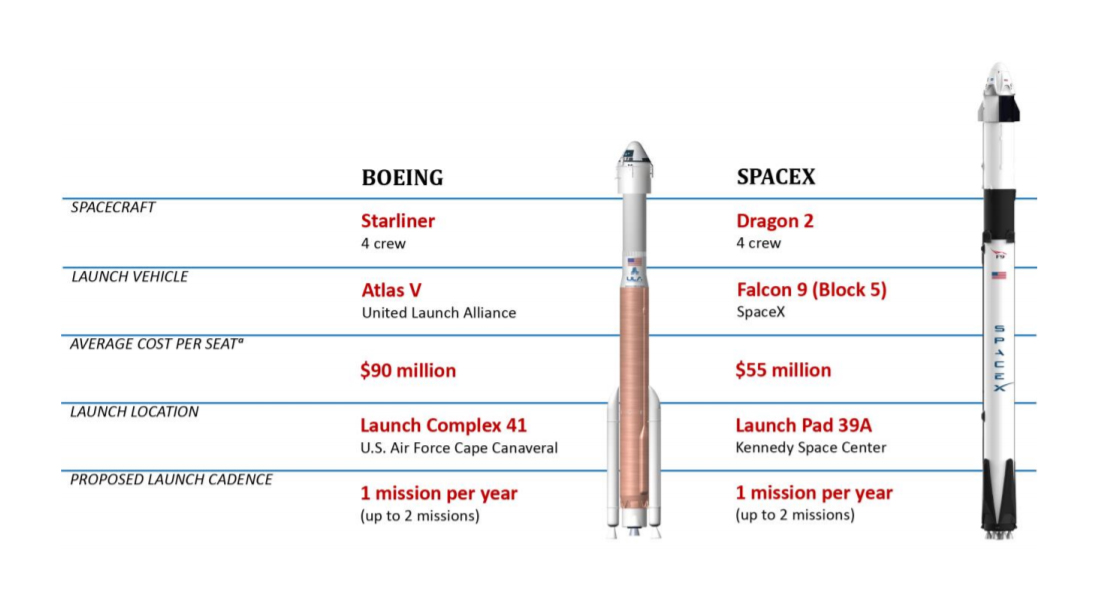
Boeing's astronaut taxi will cost NASA about 60% more per seat than SpaceX's vehicle will, according to a new report by the space agency's Office of Inspector General (OIG).
NASA will likely pay about $90 million for each astronaut who flies aboard Boeing's CST-100 Starliner capsule on International Space Station (ISS) missions, the report estimated. The per-seat cost for SpaceX's Crew Dragon capsule, meanwhile, will be around $55 million, according to the OIG's calculations.
To put those costs into perspective: NASA currently pays about $86 million for each seat aboard Russia's three-person Soyuz spacecraft, which has been astronauts' only ride to and from the ISS since NASA's space shuttle fleet was grounded in July 2011.
Related: Crew Dragon & Starliner: A Look at the Upcoming Astronaut Taxis
NASA wanted this dependence on the Russians to be temporary. So, nearly a decade ago, the agency began encouraging the development of private American-crewed vehicles.
Boeing and SpaceX emerged as the winners of this competition in September 2014, scoring Commercial Crew Transportation Capability (CCtCap) contracts currently worth $4.3 billion and $2.5 billion, respectively, to get Starliner and Crew Dragon up and running. These contracts also stipulated that each company fly six roundtrip missions to the ISS, carrying four astronauts up and back each time. (Both companies scored deals prior to the CCtCap contracts as well. Boeing has received a total of $4.82 billion from NASA's Commercial Crew Program to date and SpaceX has netted $3.14 billion. You can find those figures here.)
To calculate the per-seat estimates, the OIG team subtracted development and testing costs, which were $2.2 billion for Boeing and $1.2 billion for SpaceX, and "special studies costs" from the value of the CCtCap contracts, according to the new report.
Get the Space.com Newsletter
Breaking space news, the latest updates on rocket launches, skywatching events and more!
The pricing disparity seemed to rankle SpaceX founder and CEO Elon Musk.
"This doesn't seem right," Musk tweeted yesterday afternoon (Nov. 14), in reply to a Twitter post by Ars Technica announcing a story by space reporter Eric Berger on the OIG report's findings.
"Meaning not fair that Boeing gets so much more for the same thing," Musk added in another tweet.
Related: How SpaceX's Crew Dragon Spacecraft Works (Infographic)
More: How Boeing's CST-100 Starliner Works (Infographic)

Boeing, for its part, doesn't agree with the OIG's cost estimate. The company "is flying the equivalent of a fifth passenger in cargo for NASA, so the per-seat pricing should be considered based on five seats," Boeing representatives said in a statement emailed to Space.com. (Both Starliner and Crew Dragon can accommodate up to seven astronauts.)
NASA officials made a similar point in an emailed statement to Space.com, applying this logic to Crew Dragon missions as well: "NASA believes the seat prices identified in the OIG report are overstated because they did not account for the cargo capability of the Boeing and SpaceX systems."
Boeing also defended its higher CCtCap award, noting that the company had to develop Starliner "from scratch" whereas SpaceX based Crew Dragon off the robotic Dragon cargo capsule, which has been flying contracted resupply missions to the ISS for NASA since 2012.
"We started much later but attempted to achieve the same schedule, which is a more expensive development approach," the Boeing statement reads. "We see the overall development investment by NASA as comparable, with Boeing getting much less time for spacecraft development."
Video: Boeing. SpaceX 'Face Technical & Safety Issues' for Crewed Launches
The OIG report also found that NASA paid Boeing an additional $287 million, on top of the original CCtCap deal, "to mitigate a perceived 18-month gap in ISS flights anticipated in 2019 for the company's third through sixth crewed missions and to ensure the company continued as a second commercial crew provider." SpaceX was not notified of this deal and "was not provided the same opportunity as Boeing to propose a solution," the report reads. The OIG investigators determined $187 million of that $287 million to be "unnecessary costs."
In their emailed statement, Boeing representatives said that the extra money gives the Commercial Crew Program "additional flexibility and schedule resiliency." NASA officials, while not addressing the top-up directly, implied that it made sense.
"Subsequent to the contract awards, the company's designs matured, NASA's understanding of our safety requirements matured and the ISS configuration continued to evolve. These events required several contract modifications to ensure the safety of the astronauts, which increased the cost of the missions somewhat," NASA officials said in their emailed statement. "In addition, it should be noted that the maximum potential contract value of Boeing's and SpaceX's contracts is currently within 2.5% of the original value."
The perceived 18-month gap invoked to justify the extra $287 million never materialized, because Starliner and Crew Dragon have yet to fly any astronauts to orbit.
That should change soon. For example, Crew Dragon already has one ISS visit under its belt — a weeklong uncrewed mission called Demo-1 that took place this past March. In the next few weeks, SpaceX aims to launch a crucial in-flight abort (IFA) test, which will demonstrate Crew Dragon's ability to get astronauts out of danger in the event of a launch emergency.
If the IFA goes well, SpaceX will be clear to launch Demo-2, a crewed test flight that will ferry NASA astronauts Doug Hurley and Bob Behnken to and from the ISS. Contracted missions would then follow.
"SpaceX and NASA have worked in close partnership, applying all that we have learned from extensive testing and analysis to improve our systems and ensure Crew Dragon is one of the safest, most reliable spacecraft ever built," a SpaceX spokesperson told Space.com via email. "There is nothing more important to our company than human spaceflight, and we look forward to safely flying NASA astronauts to and from the International Space Station starting early next year."
Starliner's first ISS trip is about a month away, if all goes according to plan. Boeing aims to launch the uncrewed Orbital Flight Test, its equivalent of Demo-1, on Dec. 17.
You read the 53-page OIG report in its entirety here.
- SpaceX's Crew Dragon Abort System Aces Ground Test Ahead of Major Launch
- 'Pad Abort' Success Keeps Boeing's Starliner on Track for December Launch
- Crew Launches by SpaceX, Boeing Won't Start Until Summer 2020: Report
Mike Wall's book about the search for alien life, "Out There" (Grand Central Publishing, 2018; illustrated by Karl Tate), is out now. Follow him on Twitter @michaeldwall. Follow us on Twitter @Spacedotcom or Facebook.

Join our Space Forums to keep talking space on the latest missions, night sky and more! And if you have a news tip, correction or comment, let us know at: community@space.com.

Michael Wall is a Senior Space Writer with Space.com and joined the team in 2010. He primarily covers exoplanets, spaceflight and military space, but has been known to dabble in the space art beat. His book about the search for alien life, "Out There," was published on Nov. 13, 2018. Before becoming a science writer, Michael worked as a herpetologist and wildlife biologist. He has a Ph.D. in evolutionary biology from the University of Sydney, Australia, a bachelor's degree from the University of Arizona, and a graduate certificate in science writing from the University of California, Santa Cruz. To find out what his latest project is, you can follow Michael on Twitter.









